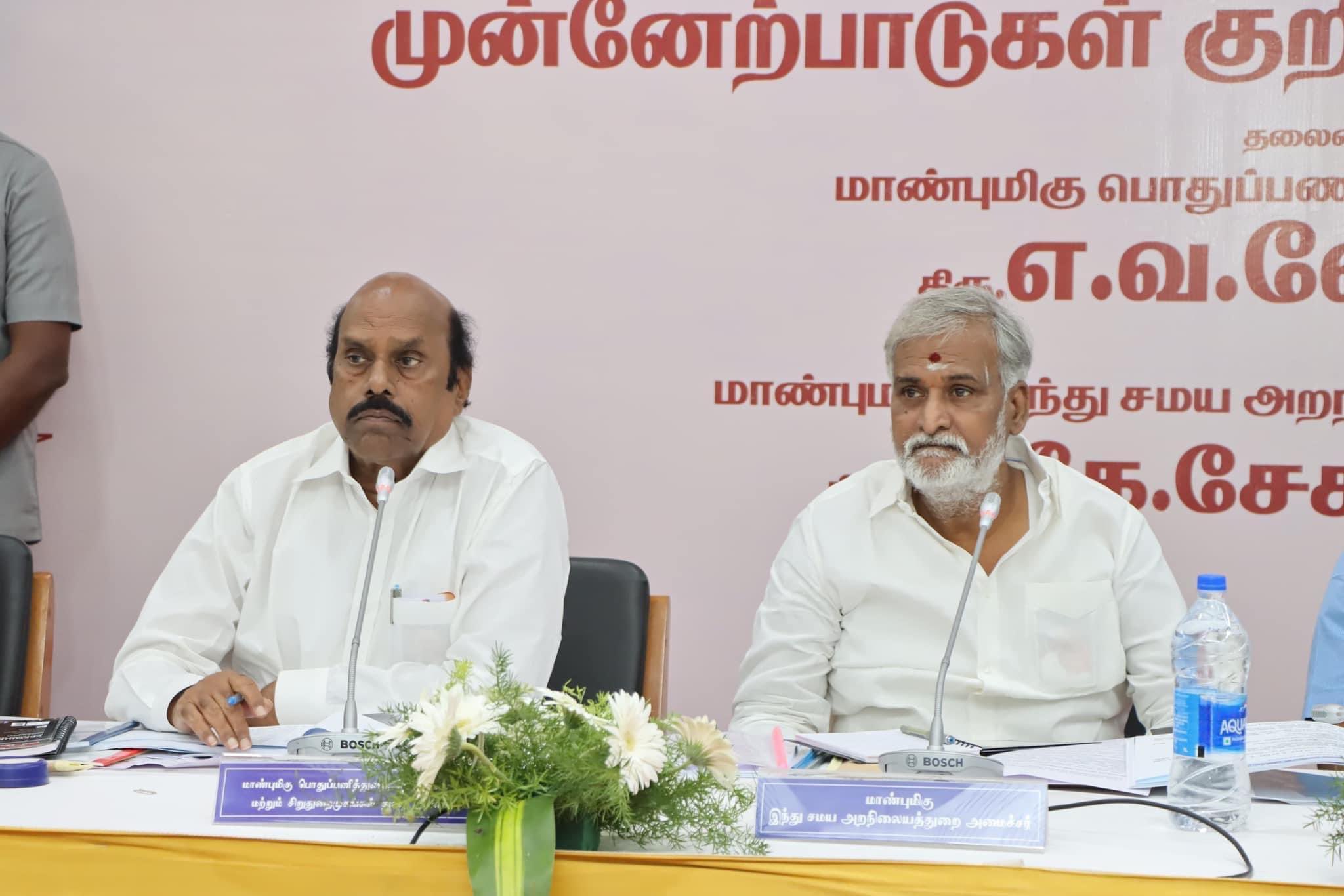Factories cannot be built on sea or sky, said Minister EV Velu, defending the acquisition of land for the industrial project.

Tamil Nadu Minister EV Velu, left. (X)
Tamil Nadu Chief Minister MK Stalin on Friday, 17 November, revoked the Goondas Act imposed on six of seven farmers who were detained by the Tiruvannamalai district collector on Thursday for peacefully protesting against land acquisition for an industrial project.
However, a farmer from Krishnagiri district, Arul, is still being detained under the Act.
In a press conference, Tamil Nadu Public Works Department, Highways, and Minor Ports Minister EV Velu said Arul was instigating the farmers in Tiruvannamalai district against the SIPCOT industrial project.
The seven farmers were detained on Thursday for peacefully protesting against the Melma SIPCOT industrial project, under Sub-section (1) of Section 3 of the Tamil Nadu Prevention of Dangerous Activities of Bootleggers, Cyber Law Offenders, Drug Offenders, Forest Offenders, Goondas, Immoral Traffic Offenders, Sand Offenders, Sexual Offenders, Slum Grabbers and Video Pirates Act, 1982 — popularly called the Tamil Nadu Goondas Act.
The Act is generally used to prevent dangerous activities prejudicial to the maintenance of public order.
“I will urge Chief Minister MK Stalin to withdraw Goondas Act imposed on the seven farmers,” the minister told the media, even as the Opposition stepped up its attack on the government over the detentions.
திருவண்ணாமலை மாவட்டம், செய்யாறு தாலுகா, மேல்மா பகுதியில், சிப்காட் தொழிற்பேட்டை அமைப்பதற்காக விவசாய நிலங்களை கையகப்படுத்துவதற்கு எதிர்ப்பு தெரிவித்து விவசாயிகள் கடந்த சில மாதங்களாக அறப் போராட்டம் நடத்தி வந்த நிலையில், அந்த அறப் போராட்டத்தை அடக்கும் விதமாக விவசாயிகள் மீது குண்டர்…
— O Panneerselvam (@OfficeOfOPS) November 17, 2023
Velu addressed the situation in the context of the Melma SIPCOT industrial project, emphasising the government’s endeavors to balance employment opportunities for the state’s youth and the welfare of farmers.
Noting the absence of factories and the Tiruvannamalai district’s reliance on agriculture, Velu said, “Unlike in Ranipet and Ambur, we don’t have SIPCOT. Citizens and elected representatives have been demanding industrial growth in the district for many years now.”
Acknowledging the demand for industry and employment, he detailed the SIPCOT initiatives in Cheyyar.
The land acquisition process for SIPCOT occurred in three phases, with the first phase involving 622 acres and 13 companies providing employment to 30,000 citizens in Cheyyar, Vandavasi, and Arani.
The second phase encompassed 1,860 acres, attracting 55 companies, thanks to the efforts of Chief Minister Stalin, Velu told reporters on Friday evening.
“Over a lakh people would find employment in the third phase. The ongoing efforts for the third phase involve acquiring 1,200 acres of barren land across nine villages. While consultations were conducted with the government, only 239 farmers out of 1,881 objected to the land acquisition,” he mentioned.
“The government is paying 2.5 times more than the market value to keep farmers content while fostering employment opportunities,” he added.
“People from other districts are instigating the farmers here. Factories should be constructed for employment and they cannot be built on sea or sky,” he said.
His comments evoked a scathing response from the state BJP chief K Annamalai.
விவசாயிகள் மீது குண்டர் சட்டம் போடப்பட்டது நாளிதழில் பார்த்துத் தெரிந்துக் கொண்டதாகவும், தொழிற்சாலைகளை வானத்திலா கட்ட முடியும் என்று விவசாயிகளை கொச்சைப்படுத்தியும் பேசிய அமைச்சர் எ.வ. வேலு அவர்களுக்கு @BJP4TamilNadu சார்பாக கண்டனங்களை தெரிவித்துக் கொள்கிறோம். pic.twitter.com/MeA1JSc7qN
— K.Annamalai (@annamalai_k) November 17, 2023
Jayaram Venkatesan, the founder of Arappor Iyakkam, an anti-corruption NGO, observed that under mounting pressure, the Tamil Nadu government appeared to have taken a step back on the issue.
“The district administration officials reached out to the farmers’ families, urging them to meet with the minister and request the cancellation of the Goondas Act,” Jayaram Venkatesan told South First.
Venkatesan criticised the use of dictatorial tactics, emphasising the need for a democratic resolution regardless of the number of agitating farmers.
He questioned the justification for invoking the Goondas Act, stating, “Where is the question of using this Act?”

Jul 26, 2024

Jul 25, 2024

Jul 21, 2024

Jul 21, 2024

Jul 21, 2024

Jul 21, 2024